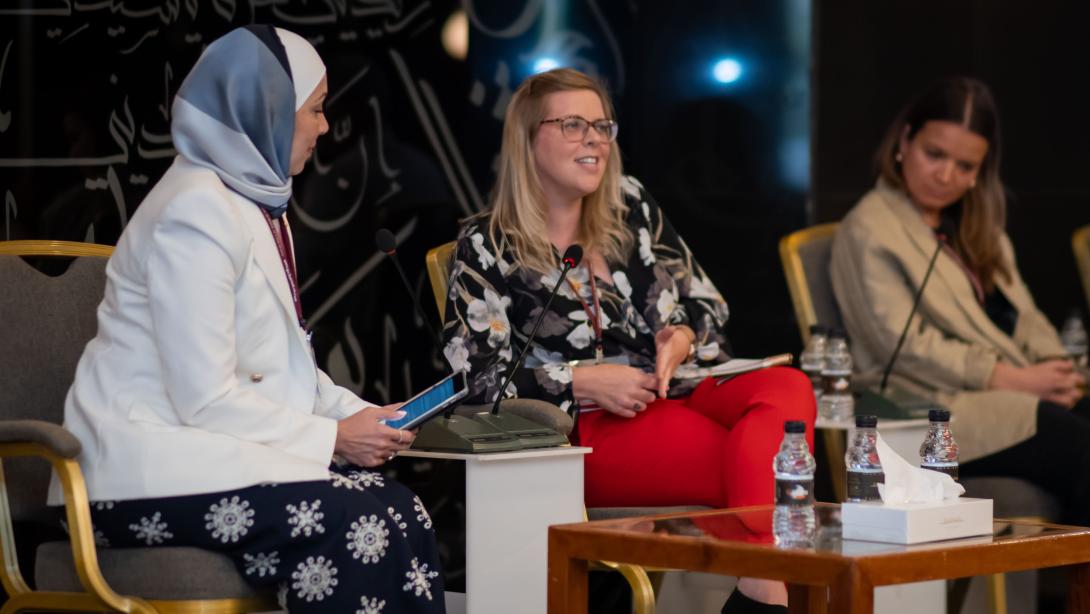Teaching in emergencies: The greatest act of leadership

Earlier this month I was invited to open the Harvard Graduate School of Education conference in Amman, which was focused on education in crisis contexts. Over 250 educators—teachers, school principals, Ministry of Education policymakers, UN and NGO staff—from across the Middle East region gathered for two days to push the Education in Emergencies (EiE) sector’s thinking on what’s most needed for students and teachers caught up in crises.
During my keynote, I asked the audience to visualize a typical EiE intervention. The picture that was painted by their responses was one of purely technical solutions—rebuilding destroyed classrooms, replacing damaged teaching and learning materials, rehabilitating school water and sanitation facilities, teacher trainings on psychological first aid, school feeding programmes, edtech for accelerated learning, and more. All of these are indeed critical investments, but there is no single solution to a problem so entrenched and complex as the continuation of education in the midst of an emergency.
With crises escalating across the world, and more than 224 million school-aged children affected by emergencies globally, these traditional EiE approaches simply aren’t creating the change required at the pace needed. Such technical solutions consume the vast majority of energy and resources of governments, ministries, donors, and practitioners, but there’s growing evidence and consciousness (for example, the recently released PISA scores) that despite all these technical solutions, educational outcomes are decreasing.
Across the Teach For All network, we see that there’s no “silver bullet” when it comes to improving education systems. That’s why our network of over 60 local partners is laser focused on the enabler of all of these technical solutions—investing in the people and leadership across all levels of an education system—from students and teachers, to parents, community members, and local leaders.
Why? Through our engagement with hundreds of leaders from across our global network, we’ve seen that because education systems are inherently human systems—made up of people in various roles in schools, administration, and policy—technical solutions alone won’t lead to the enduring changes needed across the wider ecosystem around crisis-affected children.
A question came in from the audience: “What should we prioritize when investing in leadership in emergencies?” I shared that I think crisis-impacted students deserve effective EiE leaders who can make informed, strategic decisions during complex and rapidly changing humanitarian situations. They deserve EiE leaders who possess a deep understanding of the local context, cultural sensitivities, and the dynamics of the crisis, so that they can make better decisions that lead to more impactful interventions. They deserve EiE leaders who are adaptable, who can stay centered in times of flux, navigate uncertainty, develop creative solutions, and adjust strategies in response to new challenges. And EiE leaders who ensure that limited resources—financial, human, and material—are used efficiently and transparently, maximizing the impact of education investments while minimizing wasted resources.
Across the Teach For All network, I’m seeing more and more of our partners enlist their country’s most courageous and creative talent to teach in crisis-prone communities. If an emergency hits, these teachers have then become frontline responders—whether during the earthquakes in Morocco or Nepal, conflicts in Palestine or Ukraine, or displacement in Colombia or Afghanistan—who support impacted communities to lead their own way to recovery. I feel so honored to be able to do this work, witnessing these incredible educators and local leaders who drive innovations, work with others across the system, pioneer solutions, and disseminate their learning across their country’s EiE sector.
As I wrapped up the conference keynote, I asked the audience to picture an emergency and name a greater act of leadership than standing in front of a class of students and taking up the noble calling of teaching. To all my colleagues across the broader EiE sector, I want to leave you with this same prompt— as you’re designing and implementing projects to support crisis-impacted communities do not lose sight of the students and teachers in the classrooms and remember that, in order to see the outcomes that these children deserve, EiE responses need to include both technical and adaptive solutions.



